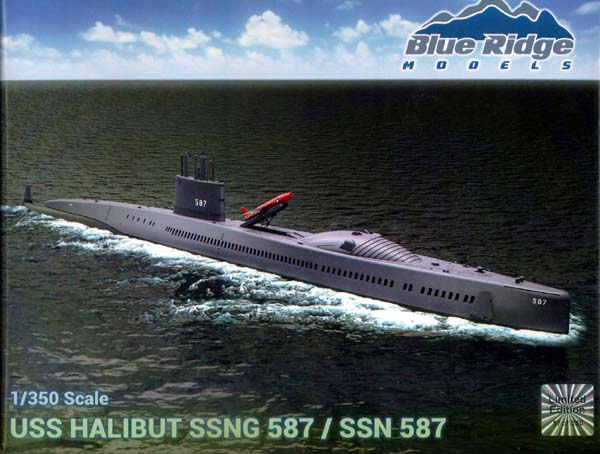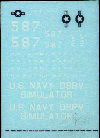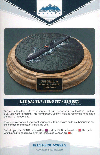USS Halibut SSNG-587 / SSN-587

Reviewed June 2016
by Timothy Dike

| HISTORY | |||||||||||||
| Begun as a diesel-electric submarine but completed with
nuclear power, Halibut was the first submarine initially designed to launch
guided missiles. Intended to carry the Regulus I and Regulus ll nuclear
cruise missiles, her main deck was high above the waterline to provide
a dry "flight deck." Her missile system was completely automated, with
hydraulic machinery controlled from a central control station.
Halibut departed on her Shakedown cruise 11 March 1960. On 25 March, underway to Australia, she became the first nuclear-powered submarine to successfully launch a guided missile. She returned to Mare Island Naval Shipyard on 18 June 1960, and after short training cruises sailed 7 November for Pearl Harbor to join the Pacific Fleet. During her first deployment she successfully launched her seventh consecutive Regulus I missile during a major Southeast Asia Treaty Organization weapons demonstration. Returning to Pearl Harbor on 9 April 1961 Halibut began her second deployment 1 May. During subsequent cruises. she participated in several missile firing exercises and underwent training. Halibut deployed for the third time to the Western Pacific in late 1961 , establishing a pattern of training and readiness operations followed through 1984. On 4 May 1964 Halibut departed Pearl Harbor for the last Regulus missile patrol to be made by a submarine in the Pacific. In total, between February 1961 and July 1964, Halibut undertook a total of seven deterrent patrols before being replaced in the Pacific by Polaris equipped submarines of the George Washington class. From September through December 1964, Halibut joined eight other submarines in testing and evaluating the attack capabilities of the Permit-class submarine. In February 1965 Halibut entered Pearl Harbor Naval Shipyard for a major overhaul, and on 15 August was re-designated as an attack submarine and given the hull classification symbol SSN-587. She sailed from Pearl Harbor on 6 September for the West Coast, arriving at Keyport, Washington, on 20 September. On 5 October she departed Keyport for Pearl Harbor and, after an eight day stop over at Mare Island, California, arrived 21 October. Halibut then began ASW operations in the area, continuing until August 1968 when she transferred to Mare Island for overhaul and installation of: side thrusters; hangar section sea lock; anchoring winches with fore and aft mushroom anchors; saturation diving (mixed gas) habitat; long and short range side-look sonar; video and photographic equipment; mainframe computer; induction tapping and recording equipment; port and starboard , fore and aft seabed skids ("sneakers"); towed underwater search vehicle ("fish") and winch; and other specialized oceanographic equipment. She returned to Pearl Harbor in 1970 and operated with the Pacific Fleet and Submarine Development Group One (SubDevGruOne) out of San Diego with attachment offices at Mare Island until decommissioning in 1976. This Limited Edition Blue Ridge Models kit is one of the first from the reborn line. This kit, CAD designed and 3D printed will appeal to the collector, casual builder and even the rivet counter. It is nicely packed in handsome packaging with all parts secured from any damage. |
|||||||||||||
| HULL PARTS | |||||||||||||
| The hull is well cast with sharply defined details and minimal flash. Limber holes and vents are very nicely defined. The missile bay interior is nicely done in case you want to display the included Regulus missile in the bay. Mounting sockets are cast and a help locate the separate parts such as the sail. | Click images
to enlarge |
||||||||||||
 |
|||||||||||||
|
|||||||||||||
| SAIL AND SMALL PARTS | |||||||||||||
| Two different sail options are provided. The first one is the shorter one for the as built on the SSNG version and also with the taller one used on the special operations version. A nicely done DSRV includes a separate escape pod. A variety of periscope, antenna, and snorkels are provided to mount on the sail. |  |
||||||||||||
|
|||||||||||||
| PROPELLERS | |||||||||||||
| The props are properly shaped in left and right hand configurations. These propellers are extremely well detailed and almost flash free. One thing missing from the kit is Brass rod to mount the props to. But I'm betting most of us already have some of that on hand. |  |
||||||||||||
|
|||||||||||||
| PHOTOETCH | |||||||||||||
| Photo etch is provided for the finer details such as the stanchions, side thruster openings and blanking plates. Wings for the Regulus missile can be folded or shown ready for launch. |  |
||||||||||||
| DECALS | |||||||||||||
| Decals include markings for both versions as well as stars and bars for the Regulus missile. Foot rails for the sail, site thruster openings and blanking plates, and the wings for the Regulus missile. |  |
||||||||||||
| INSTRUCTIONS | |||||||||||||
| The instructions are sixteen pages in booklet form, very well drawn utilizing the same CAD that was used to create the master. Parts are labeled and their location is clearly shown, color coded for both the SSNG Regulus version and the SSN Special Ops version. |  |
||||||||||||
|
|||||||||||||
| Conclusions: | |||||||||||||
 This
Blue Ridge Models submarine kit represents yet another state of the art
kit.of this pioneering sub design. Excellent casting and sharp details
should make this an easy project for the beginner as well as a good platform
for the super detailer. This is a limited edition kit and only 250
are planned. So get yours before they're gone. This
Blue Ridge Models submarine kit represents yet another state of the art
kit.of this pioneering sub design. Excellent casting and sharp details
should make this an easy project for the beginner as well as a good platform
for the super detailer. This is a limited edition kit and only 250
are planned. So get yours before they're gone.
This is kit # BRM35032- 1/350 Blue Ridge Models USS Halibut SSNG/SSN-587 2-in-1 Submarine Model Kit with a list price of $89.95. You can get yours from Freetime Hobbies. Stay tuned as more subs are coming in 1/350 scale from Blue Ridge Models. |
|||||||||||||
